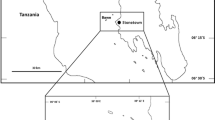Abstract
An investigation of the ecology of toxicity in marine sponges from different latitudes on the North American continent was made. Results indicated that toxicity in sponges increased with decreasing latitude. Three of the 34 species (9%) of sponges from San Juan Island, Washington, USA (48°N), were toxic to fishes. Nine of the 44 species (20%) of sponges from Santa Catalina Island, California, USA (33°N), were toxic. Seven of the 11 species (64%) of sponges from Zihuatanejo Bay, Guerrero, México (17°N), were toxic. Twenty-seven of the 36 species (75%) of sponges from La Blanquilla, Veracruz, México (19°N), were toxic. Most of these toxic sponges are openly exposed to fishes. The most common exposed sponges proved to be highly toxic to fishes. Force-feeding experiments conducted with wrasses demonstrated the effectiveness of the toxin of sponges. A hypothesis is proposed which explains the relationship between species diversity of fishes and sponge toxicity with latitude.
Similar content being viewed by others
Literature Cited
Bakus, G.J.: The effects of fish-grazing on invertebrate evolution in shallow tropical waters. Occ. Pap. Allan Hancock Fdn 27, 1–29 (1964)
—: Defensive mechanisms and ecology of some tropical holothurians. Mar. Biol. 2, 23–32 (1968)
—: Energetics and feeding in shallow marine waters. Int. Rev. gen. exp. Zool. 4, 275–369 (1969)
—: The biology and ecology of tropical holothurians. In: Biology and geology of coral reefs, Vol. 2. pp 325–367. Ed. by O.A. Jones and R. Endean. New York: Academic Press 1973
Baslow, M.H.: Marine pharmacology, 286 pp. Baltimore: The Williams and Wilkins Co. 1969
Burkholder, P.R.: Ecology of marine antibiotics and coral reefs. In: Biology and geology of coral reefs, Vol. 2. pp 117–182. Ed. by O.A. Jones and R. Endean, New York: Academic Press 1973
Clemens, W.A. and G.V. Wilby: The fishes of the Pacific coast of Canada. Bull. Fish. Res. Bd Can. 68, 1–368 (1946)
De Laubenfels, M.W.: The marine and fresh-water sponges of California. Proc. U.S. natn. Mus. 81, 1–140 (1932)
Feder, H.M.: Escape response in marine invertebrates. Scient. Am. 227, 93–100 (1972)
Gosline, W.A. and V.E. Brock: Handbook of Hawaiin fishes, 372 pp. Honolulu: University of Hawaii 1960
Graham, A.: Molluscan diets. Proc. malac. Soc. Lond. 31, 144–158 (1955)
Halstead, B.W.: Poisonous and venomous marine animals of the world. Vol. 1. Invertebrates, 994 pp. Washington, D.C.: U.S. Government Printing Office 1965
Marshall, T.C.: Fishes of the Great Barrier Reef and coastal waters of Queensland, 566 pp. Sydney: Angus & Robertson 1964
Nigrelli, R.F., S. Jakowska and I. Calventi: Ectyonin, antimicrobial agent from the sponge Microciona prolifera Verrill. Zoologica, N.Y. 44, 1973–1976 (1959)
Quast, J.C.: Estimates of the populations and the standing crop of fishes. Calif. Fish Game 139, 57–79 (1968)
Randall, J.E. and W.D. Hartman: Sponge-feeding fishes of the West Indies. Mar. Biol. 1, 216–225 (1968)
Russell, F.E.: Pharmacology of toxins of marine organisms. In: Pharmacology and toxicology of natural occurring toxins, Vol. 2. pp 3–114. Ed. by H. Raskova. Pergamon Press 1971
Scott, T.D.: The marine and fresh water fishes of south Australia, 255 pp. Adelaide: W.L. Hames 1962
Sigel, M.M., L.L. Wellham, W. Lichter, L.E. Dudeck, J.L. Gargus and A.H. Lucas: Anticellular and antitumor activity of extracts from tropical marine invertebrates. In: Food-drugs from the sea, pp 281–294. Ed. by H.W. Youngken. Washington, D.C.: Marine Technology Society 1970
Starck, W.A.: A list of fishes of alligator Reef, Florida with comments on the nature of the Florida reef fish fauna. Undersea Biol. 1, 1–40 (1968)
Stempien, M.F., G.D. Ruggieri, R.F. Nigrelli and J.T. Cecil: Physiologically active substances from extracts of marine sponges. In: Food-drugs from the sea, pp 295–305. Ed. by H.W. Youngken. Washington, D.C.: Marine Technology Society 1970
Author information
Authors and Affiliations
Additional information
Communicated by J. S. Pearse, Santa Cruz
Rights and permissions
About this article
Cite this article
Green, G. Ecology of toxicity in marine sponges. Marine Biology 40, 207–215 (1977). https://doi.org/10.1007/BF00390876
Accepted:
Issue Date:
DOI: https://doi.org/10.1007/BF00390876




